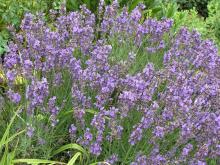
High Plains Gardening
The gardening website of the Texas High Plains Region

Outstanding shrubby perennial fragrant herb for the garden! Very good soil drainage is the key to growing lavender, it does not like moist, compacted clay soil. Lavender appreciates supplemental irrigation every 2-4 weeks, if not provided naturally. Trim back in late winter or early spring by not more than a third, or just trim down last years flower stems. Triming too much off the plant will kill it.
L. angustfolia is cold hardy to Zone 7, L. x intermedia, L. lanata, L. latifolia are hardy to Zone 7 and can usually be grown in our climate. These are all members of the Spica Group of lavender, the English lavenders. Spanish lavender, the Stoechas Group, that we sometimes see sold in fall when suppliers dump their supplies on home improvement centers, have slim chance of wintering over – buyer beware! There should be ample varieties for the lavender fancier to choose from, if not locally, then certainly by catalog and Internet. Lavender is in vogue in the Western garden, due its fire retardant quality. I have lavender planted in my xeristrips, but do not water them but once a month. However, twice a month won’t hurt them.
Sunny bed or border. Fragrant garden, herb garden. Sun/sun, part shade. Planted as a fire-retardant in dry areas. Grown for it's scent and oil in fields. Grows well in hot, dry areas.
Trim out spent stems only down to leaf cluster where the stem emerges. Trim out dead branches.